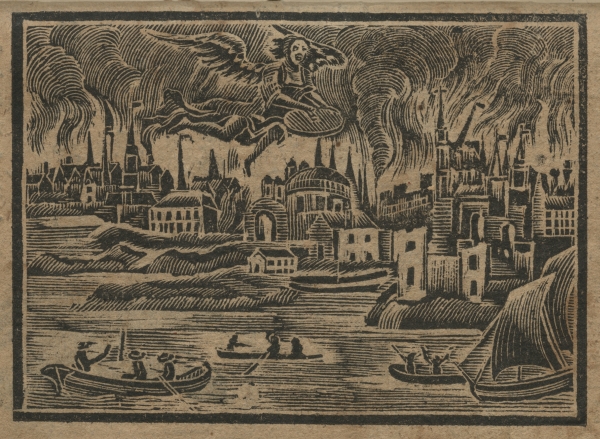· 7 ·
A Scotsman, Thomas Chippendale, and the Green Dragon Tavern
KEMBLE WIDMER
In 1974, Mary Ellen Hayward Yehia identified a group of chairs and settees as constituting one of three types of distinctive eighteenth-century Boston carving styles, based on their “unusual, asymmetrically designed carved decorations,” similar dimensions, and use of two splat designs.1 Using her initial observations as a base, research during the past twenty years has significantly expanded the number of acknowledged examples of this important body of work. Circumstantial evidence now suggests that the craftsman responsible for making the pieces in this select group is the Scottish immigrant James Graham (1728–1808).
In January 1997, a pair of New England mahogany chairs with owl’s-eye splats were offered at Christie’s. Their unusual construction spurred the research that led to the conclusions presented in this study.2 The chairs, both in excellent condition, retained their original over-the-seat upholstery foundation and seat construction (fig. 1). Although attributed to Boston or Salem, they deviated from standard practice, lacking stretchers and the verticality of New England chairs; their shorter size and broader stance more closely resembled English chairs. Close examination revealed many details atypical of New England chairmaking from this period:
- • The shoe at the base of the splat was tenoned into grooves in the rear legs (fig. 2), which required additional labor compared to the usual method of nailing the shoe to the rear rail.
- • The knee brackets were tenoned into the front legs and made of laminated mahogany mounted to a secondary backing of pine, two practices seldom observed in New England (fig. 3).
- • The wood’s sharp edges, even those hidden by upholstery, were fastidiously chamfered. Much Boston cabinetwork of the mid-eighteenth century is characterized by joinery practices that saved material and labor. Unexposed surfaces were seldom finished, and hidden secondary woods were unfinished and of minimal dimensions.
- • The nail holes were all counterbored so that the nail heads did not protrude above the surface (see fig. 3).
- • The use of four triangular corner blocks to secure the frame was typical of Massachusetts chairs, but the addition of four crossbraces supporting the seat was not (fig. 4).
- • The crest rail was decorated with three long, incised grooves that cut into the ear and extended toward the splat, another feature uncommon in New England pieces (fig. 5).
- • The pair lacked stretchers, in contrast to most Massachusetts chairs of the period.
- • The poorly carved claw-and-ball feet stood out as lacking the refinement of the balance of the design.
Two years later, in January 1999, again at a Christie’s sale, a chair was offered from a set originally owned by Moses Gill (1734–1800), lieutenant governor of Massachusetts. With its carved loop and diamond splat, fully carved crest rail, stop-fluted stiles, asymmetrical C-scroll carved knees, and hairy paw feet, the Gill chair feaured the highest form of Boston carving and displayed the traits of the group Yehia had identified. The chair closely matched another example with the same history of ownership by Gill that had been acquired a few years earlier by the Museum of Fine Arts, Boston (fig. 6).3
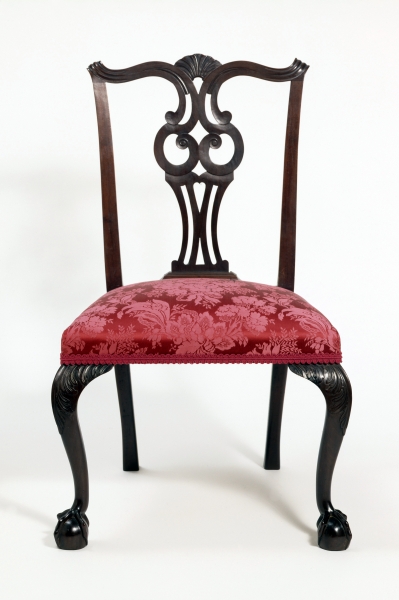
FIG. 1. Side chair with owl’s-eye splat, attributed to James Graham (1728–1808), Boston, 1754–58. Mahogany, maple, white pine; h 36¾, w 23½, d 21. Private collection. Photo, Winterthur Museum.
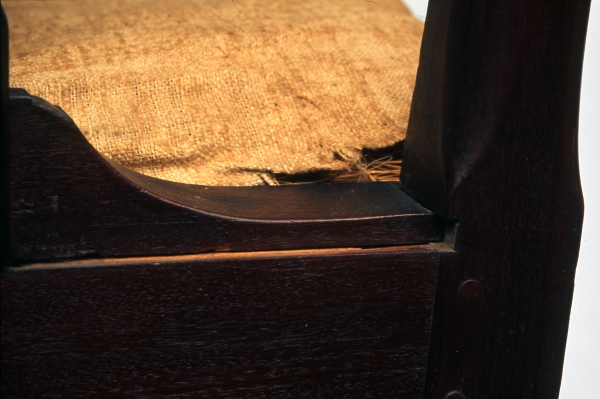
FIG. 2. Rear rail and shoe of the side chair in fig. 1. Conservation photo, Winterthur Museum.
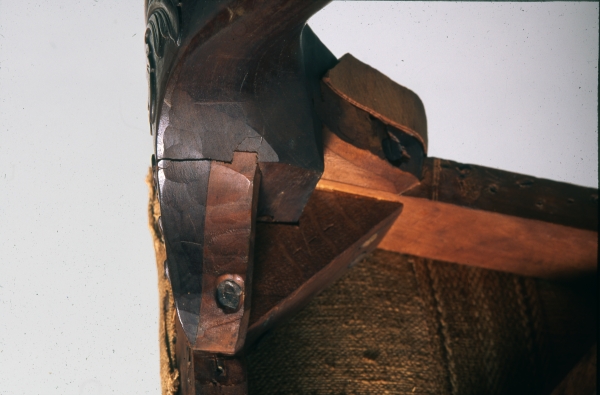
FIG. 3. Corner block and knee brackets of the side chair in fig. 1. Conservation photo, Winterthur Museum.
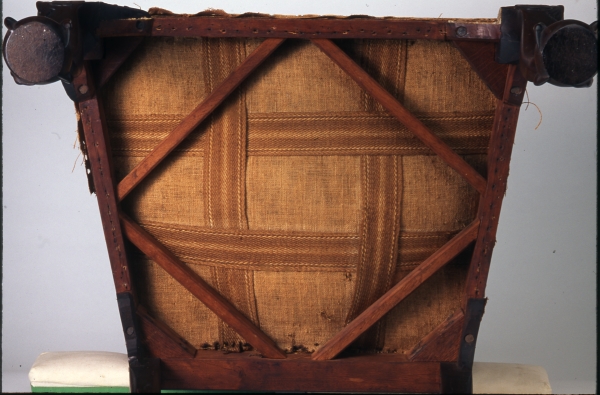
FIG. 4. Underside of the side chair in fig. 1, showing original upholstery foundation, cross braces, and corner blocks. Conservation photo, Winterthur Museum.
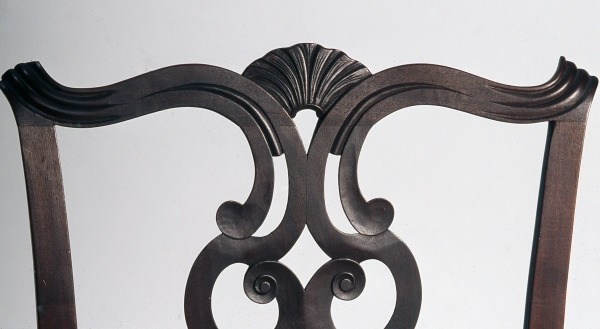
FIG. 5. Crest rail of the side chair in fig. 1. Conservation photo, Winterthur Museum.
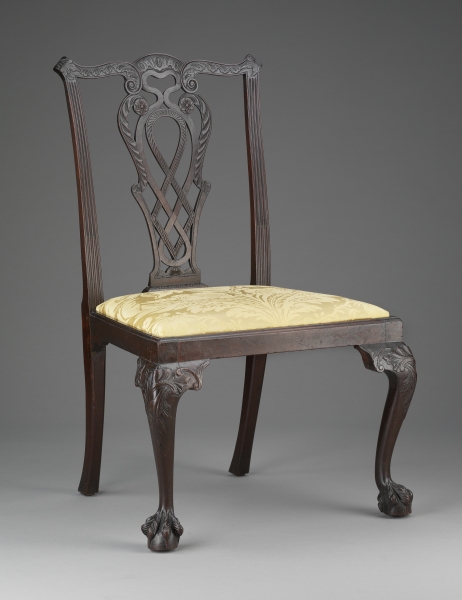
FIG. 6. Side chair with loop and diamond splat, attributed to James Graham, Boston, 1759–60. Mahogany, red oak, soft maple; h 38¼, w 24⅝, d 18⅞. Museum of Fine Arts, Boston; Gift of Priscilla Quincy Weld in memory of her mother and grandmother, Ruth Draper Peters and Alice Ames Draper, and Elizabeth Marie Paramino Fund in memory of John F. Paramino, Boston Sculptor, Arthur Tracy Cabot Fund, Ernest Kahn Fund, John Wheelock Elliott and John Morse Elliott Fund, Alice M. Bartlett Fund, and Edwin E. Jack Fund (1996.52). Owned by Moses and Sarah (Prince) Gill of Boston, the chair was possibly acquired about the time of their marriage in 1759.
Among the offerings at the same sale was a relatively simple mahogany chair with a C-scroll splat, acanthus leaf carving on the knees, and scribed-pad feet of a type usually attributed to Salem (figs. 7–9).4 Although the Christie’s pair with owl’s-eye splats, the Gill chair, and the C-scroll example had different splats, feet, and carved decoration, their construction linked them to the same shop:
- • All were made of dense, close-grained mahogany with a veneered rear seat rail. Where the owl’s-eye splat chairs used maple as the secondary wood for the rear rail, both chairs in the 1999 sale (the Gill chair and C-scroll example) used oak, a highly unusual secondary wood in New England chairs.
- • The acanthus leaf pattern on the knees of the C-scroll chair (see fig. 8) was carved from the same template used on the chairs with owl’s-eye splats.
- • Ogee-shaped side rail brackets were attached to the rear leg with a mortise-and-tenon pinned joint and nailed to the side rail.
- • Nails used in the corner blocks, knee brackets, and side rail brackets were counterbored, and all sharp interior edges were chamfered. Many of the wrought nails had round heads, as opposed to the conventional rose head.
- • Both chairs in the 1999 auction had slip seats numbered with Roman numerals inside the rear seat rail, using a ⅝-inch chisel. The original seat frames were also numbered. Neither slip-seat chair had large diagonal seat braces.
- • Original pins for the mortise-and-tenon joints were small and round (⅛ to 3/16 inch in diameter).
- • Rear feet were square in cross-section below the seat rail and flared outward at the base.
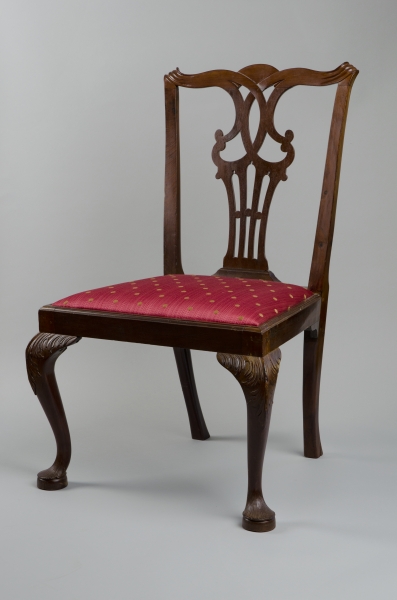
FIG. 7. Side chair with C-scroll splat, attributed to James Graham, Boston, 1758–70. Mahogany, oak, maple, birch; h 35⅞, w 23⅜, Seat d 179/16. Private collection. Photo, Laura Wulf.
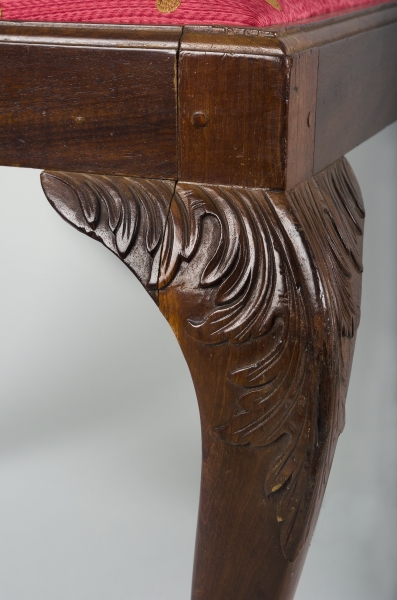
FIG. 8. Acanthus-leaf knee carving on the side chair in fig. 7. Photo, Laura Wulf.
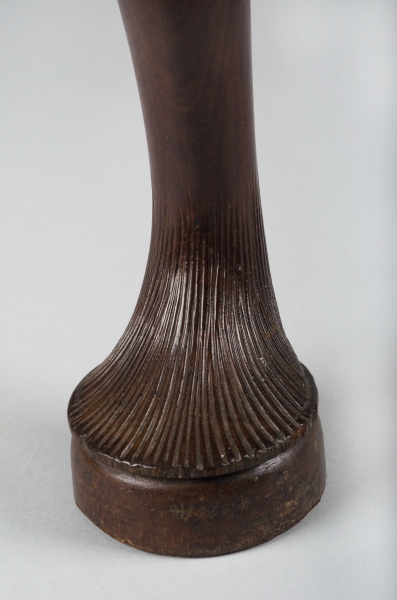
FIG. 9. Pad foot with scribed decoration on the side chair in fig. 7. Photo, Laura Wulf.
IDENTIFYING THE GROUP
Based on these parameters, an extensive search was undertaken to identify the different chair forms that could be attributed to this talented but unknown chairmaker. The results are shown in the appendix, which lists chairs by splat type and key design features. Currently, twenty-nine distinct chair sets, encompassing one hundred discrete examples, have been identified. The chairmaker offered his customers at least eleven different splats. Of equal importance is the wide range of options within those designs. Buyers could choose claw-and-ball, hairy paw, or scribed-pad feet. They also had a choice of four knee decorations, three forms of chair stiles, and a variety of woods, as well as an overupholstered or removable slip seat. Additional variations included the shaping of knee brackets and the treatment of the ears to the crest rail, although the latter may have been dictated by the splat design. The significant number of variations in a chair’s overall composition allowed the identification of the sets. Although none of the sets listed in the appendix have exactly the same design, the high number of options offered made it possible to determine whether or not chairs were from the same set and thus to re-assemble (on paper) sets that had become dispersed over time.5
The large group of seating furniture that could now be assigned to a single shop included chairs and settees featuring the varied splat designs, discussed below in terms of their probable cost and number of surviving examples.
Lancet and Keyhole
The least costly splat design was probably the lancet and keyhole, as seen on a corner chair sold at Sotheby’s in 2010 (fig. 10).6 Though the splat was simple, the buyer selected several other expensive options, including well-carved claw-and-ball feet, fluted stiles supporting the arms, and a compass seat. The chair also incorporates carved scallop-shell knees, a rare option from the shop. The only known survivor of such a design, this elegant example is a beautiful composition that marries form and function.
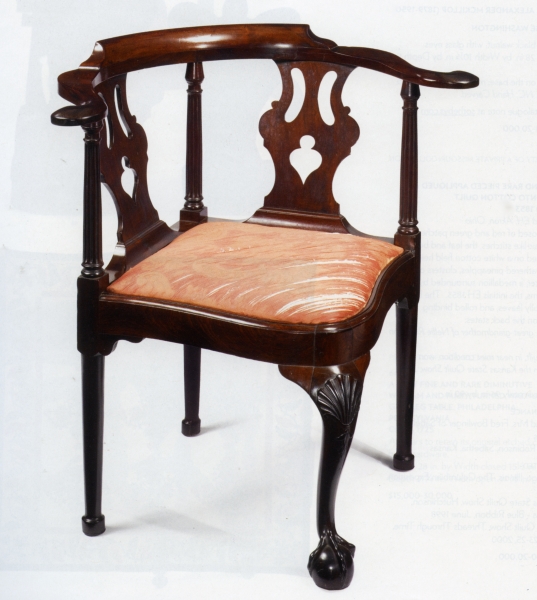
FIG. 10. Corner chair with lancet and keyhole splat, attributed to James Graham, Boston, 1763–75. Mahogany, birch; h 31⅛, Seat d 25½. Private collection. Photo, Sotheby’s.
C Scroll
The basic C-scroll splat was probably the next economical option. This splat formed the basis for two more complicated designs: C scroll and diamond, and C scroll and chevron. The chair illustrated here (see fig. 7) is another good example of available options. Although the chair is made of choice mahogany, its price was lowered by selecting a basic splat, a less expensive slip seat, and the least expensive foot option, scribed-pad feet (see fig. 9). The chair is elevated from a basic appearance by the acanthus-leaf carved knees (see fig. 8). Surprisingly few sets with this splat have survived, including one of only three chair sets made of a primary wood other than mahogany.7 This design was introduced early in the chairmaker’s career, as evidenced by a pair of chairs at King’s Chapel in Boston that retain laminated knee brackets (similar to those on fig. 3). Two of the three surviving C-scroll sets have the extended three grooves of the crest rail ear, another early feature (see fig. 5) that was subsequently modified to one of two ogee and double-bead forms.
C Scroll and Diamond
Although not as popular in New England as the owl’s-eye splat, this design was frequently used in other colonies and in England.8 Four sets of twenty-one chairs in total are documented. This splat was probably at the lower end of the price spectrum; two of the four sets were made of walnut and featured the less expensive scribed-pad foot (fig. 11). A refined product using this splat is illustrated in a set of eight chairs (seven side chairs and one armchair) that incorporates finely molded claw-and-ball feet and acanthus-leaf carved knees.
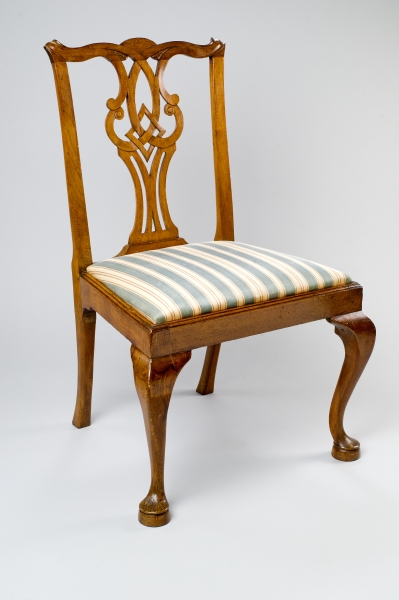
FIG. 11. Side chair with C-scroll and diamond splat, attributed to James Graham, Boston, 1758–75. Black walnut, maple, oak; h 35⅜, w 235/16. Private collection. Photo, Ralph Morang.
C Scroll and Chevron
The second most complete set from the shop consists of eight side chairs and one corner chair of this design (fig. 12). Long attributed to either Salem or Marblehead because of their descent in the Hinckley family of the latter town, the chairs exhibit all the construction and design details of the workshop discussed here. This is the only known set featuring this splat design, which, despite or perhaps because of its intricacy, never attained the popularity of other forms.
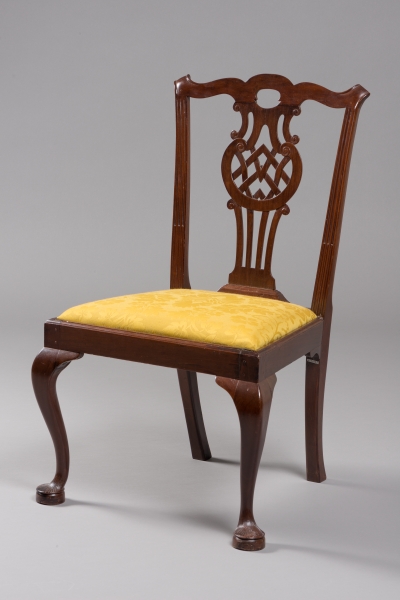
FIG. 12. Side chair with C-scroll and chevron splat, attributed to James Graham, Boston, 1760–75. Mahogany, red oak; h 37½, w 23¾, Seat d 17¾. Colonial Williamsburg Foundation; Gift of Mr. and Mrs. Thomas W. Wood (1974-36, 1).
Figure Eight and Diamond
From the survival of eight different sets, double the quantity known for any other splat design within the group, it may be inferred that this design was the most popular (fig. 13). Two of the sets are well documented. One set of six descended through the family of Dr. Augustus Holyoke (1728–1829) of Salem and was probably purchased in either 1755 or 1759.9 Another set was owned by the Reverend Joseph Willard (1738–1804), president of Harvard College.10
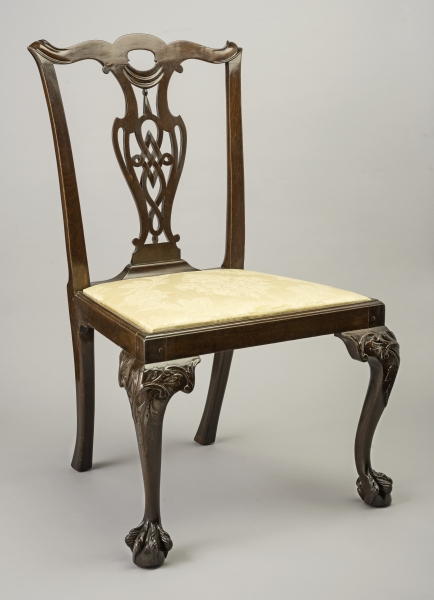
FIG. 13. Side chair with figure eight and diamond splat, attributed to James Graham, Boston, 1758–70. Mahogany, white oak; h 36⅞, w 23½, Seat d 17½. Winterthur Museum; Gift of Henry Francis du Pont (1952.0242).
Owl’s Eye
The owl’s-eye splat was the most popular Massachusetts chair design, but only three sets are confirmed to be from this shop. One was probably purchased by Dr. Bezaleel Toppan (1704/5–1762) of Salem, father of Mary, at the time of her wedding to Benjamin Pickman (1740–1819) in 1762 (fig. 14).11 Comparison of the foot carving of a chair from this set to an earlier chair shows a change in carving style as it progressed from an awkward to a more refined design (figs. 15, 16). That evolution of skill in carving the feet continued, as seen on a card table (fig. 17), and is one of the best indications of the general creation date of individual sets.
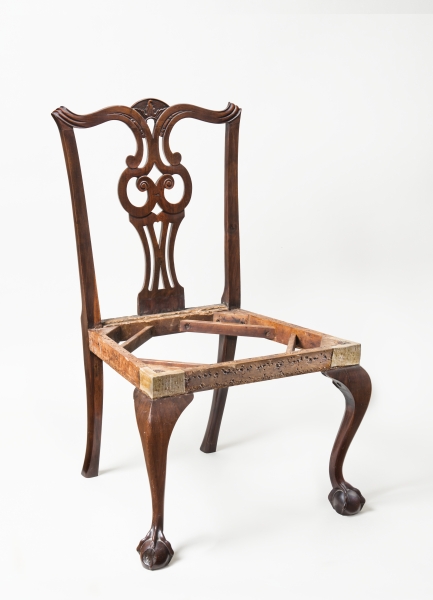
FIG. 14. Side chair with owl’s-eye splat, attributed to James Graham, Boston, ca. 1762. Mahogany, maple, oak; h 36¼, w 23¼, Seat d 17¾. Private collection. Photo, Gavin Ashworth. Possibly purchased by Dr. Bezaleel Toppan for his daughter, Mary, about the time of her marriage to Benjamin Pickman of Salem in 1762. The original cross braces and corner blocks are visible in this view.
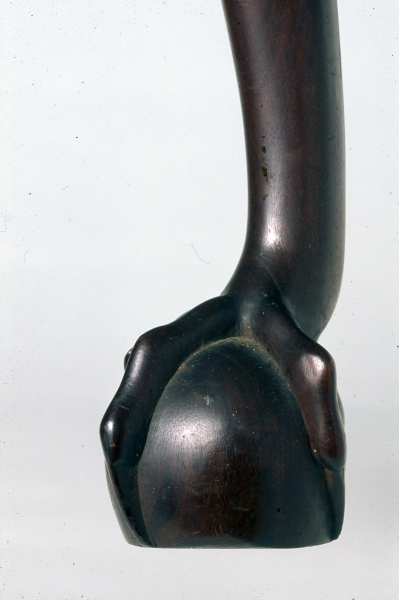
FIG. 15. Claw-and-ball foot of the side chair in fig. 1. Conservation photo, Winterthur Museum. Figs. 15–17 reveal a chronological progression in carving styles. Here, the claws are crudely appended to the leg, the knuckles of the claws lack definition, and there is no sense of muscle tone as the claws grasp the ball.
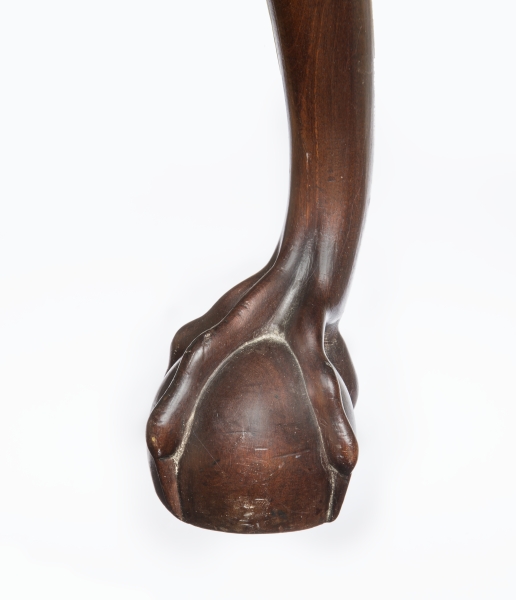
FIG. 16. Claw-and-ball foot of the side chair in fig. 14. Photo, Gavin Ashworth. Comparison of this foot to the one in fig. 15 reveals several improvements. The craftsman has created a more realistic transition from the leg to the claw and given greater definition to the knuckles. Also, tendons are visible between the claws, which give the impression of the claw firmly grasping the ball.
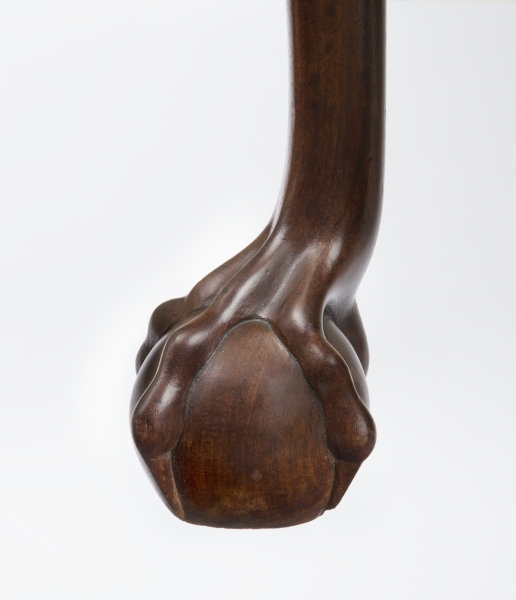
FIG. 17. Claw-and-ball foot of the card table in fig. 32. Photo, Gavin Ashworth. This foot represents the latest of the three illustrated here (figs. 15–17). Compared to the previous two, the transition from foot to claw has been shortened but is still realistic. The knuckles here are more pronounced and the ball is more curved at the base. Also, like many Boston chairs, the side claws rake back rather than descend straight down.
Gothic Arch
Whereas the owl’s-eye splat chair is loosely derived from plate 4 of Robert Manwaring’s Cabinet and Chairmaker’s Real Friend and Companion, the Gothic arch pattern (fig. 18) is one of only two Massachusetts chair designs that faithfully duplicate a specific design from Thomas Chippendale’s Gentleman and Cabinet-Maker’s Director (fig. 19).12 The combination of carving on the crest rail and top of the splat, acanthus-leaf carved knees, and carved claw-and-ball feet achieves perfect harmony, more than any other example. The design appears to be rare; only one set is known.
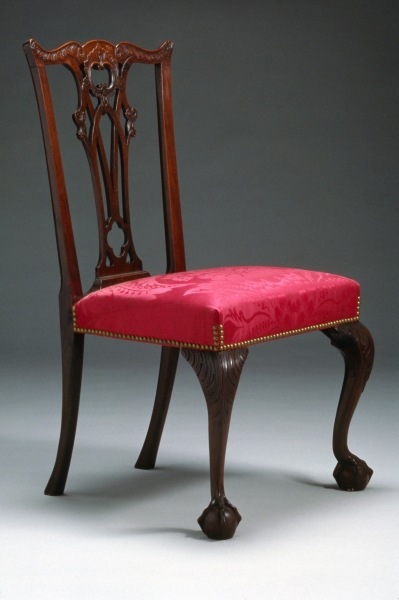
FIG. 18. Side chair with Gothic arch splat, attributed to James Graham, Boston, 1756–70. Mahogany, soft maple, birch; h 38, w 22⅞, Seat d 17⅞. Milwaukee Art Museum; Gift of Friends of Art (M1976.37).
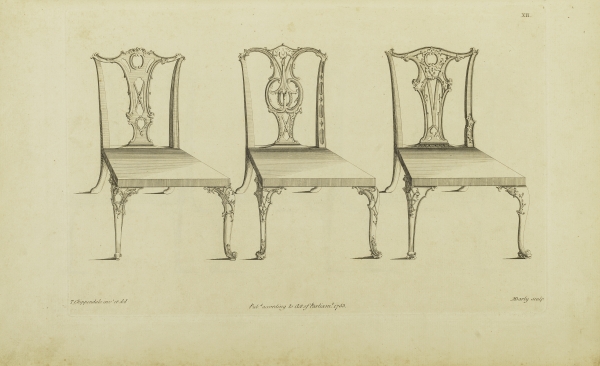
FIG. 19. “Designs for chairs.” From Thomas Chippendale, The Gentleman and Cabinet-Maker’s Director (London, 1754), pl. 12. Winterthur Library; Printed Books and Periodicals Collection.
V Shape with Double Lancet and Keyhole
In developing another sophisticated form, this shop may have accessed either plate 10 of William Ince and John Mayhew’s Universal System of Houshold Furniture (ca. 1762) or an English chair (figs. 20, 21).13 The example shown here was purchased by a customer who could afford the most expensive options of stop-fluted stiles, asymmetrical knee carving, and hairy paw feet complementing this well-carved splat design. Less costly sets with this splat are known, but they do not include expensive options. The elaborate crest-rail ear carving is seen only on this design.
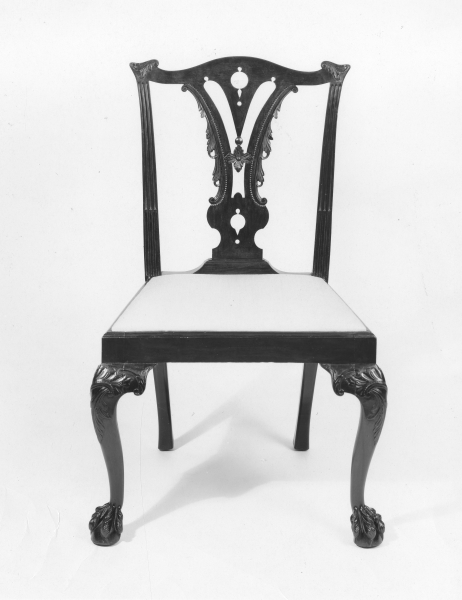
FIG. 20. Side chair with V shape with double lancet and keyhole splat, attributed to James Graham, Boston, 1758–70. Mahogany, oak; h 37½, w 25, Seat d 189/16. Private collection. Photo, Israel Sack Inc., Archive, Yale University Art Gallery, New Haven, Connecticut.
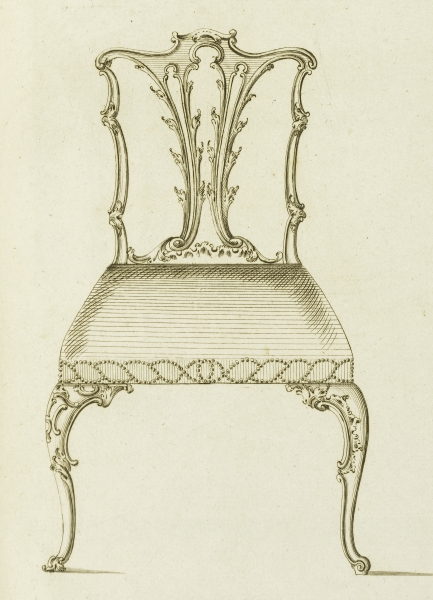
FIG. 21. Design for “Parlour Chair.” From William Ince and John Mayhew, The Universal System of Household Furniture . . . (London, ca. 1762), pl. 10. Winterthur Library; Printed Books and Periodicals Collection.
Loop and Diamond
The wealthiest families of Boston and Salem were candidates for purchasing this exceedingly expensive design. Individual chairs appear to survive from four sets, three of which have prominent pedigrees. All incorporate fully carved loop and diamond splats and crest rails, asymmetrical knee carving, and stop-fluted stiles. The sets differ only in the choice of feet (claw and ball or hairy paw) and seat type (removable or overupholstered). In addition to the set owned by Moses Gill (see fig. 6), which consists of five side chairs and one slipper chair, a set of ten chairs, consisting of eight side chairs and two armchairs, was owned by descendants of Governor Jonathan Belcher (1681/82–1757) of Massachusetts.14 The most famous chair from the shop is an armchair sold to Elias Hasket Derby (1739–1799) of Salem, possibly at the time of his marriage in 1761 to Elizabeth Crowninshield (fig. 22).15 On the underside of the rear seat rail is an inscription recording the chair’s honored position: it provided seating for President George Washington when he visited Salem in 1789.
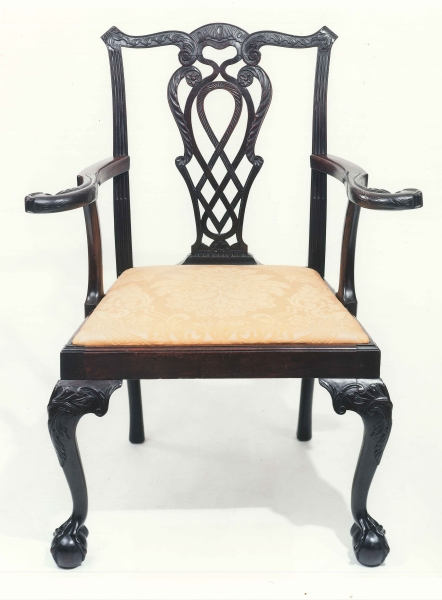
FIG. 22. Armchair with loop and diamond splat, attributed to James Graham, Boston, ca. 1761. Mahogany, birch; h 38, w 29, Seat d 16½. Private collection. A brass plate on the rear seat rail identifies Elias Hasket Derby (1739–1799) of Salem as the original owner. Derby married Elizabeth Crowninshield, also of Salem, in 1761.
Interlaced Scrolls
Examples of this English design are found in chairs from New York, Philadelphia, and Massachusetts. Although popular throughout the colonies, there appears to be only one surviving set from this Boston shop (fig. 23); it and the next example differ significantly in details from the shop’s earlier work. This chair is considered to have been made in the latter stages of the shop’s history because of two sculptural changes. Earlier claw-and-ball-foot chairs feature relatively thin talons with elongated nails, more reminiscent of Salem work rather than of Boston. The claws on this pair are much different and typical of the Boston form: a thick claw with an abbreviated nail and a pronounced retraction of the side claw (fig. 24). In addition, the chair features the later-period molded stiles above the seat. Nevertheless, an attribution to the same chairmaker of the previous examples is suggested because of identical interior construction methods and the chairs’ overall stance: a wider seat and shorter height than were typical for New England chairs. It is possible that the carving of the feet on this set was performed by another craftsman.
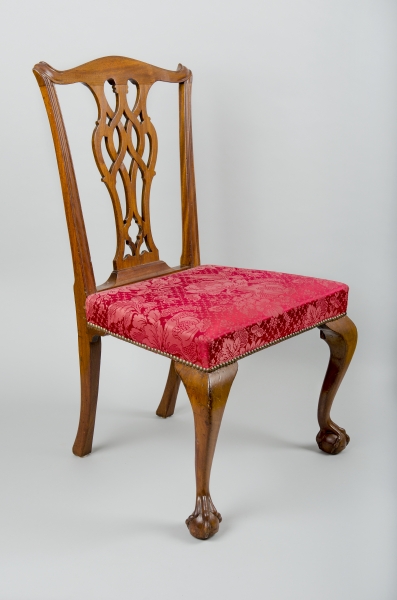
FIG. 23. Side chair with interlaced scroll splat, attributed to James Graham, Boston, 1770–85. Mahogany, white pine, probably maple; h 37, w 23⅝, Seat d 17½. Private collection. Photo, Laura Wulf.
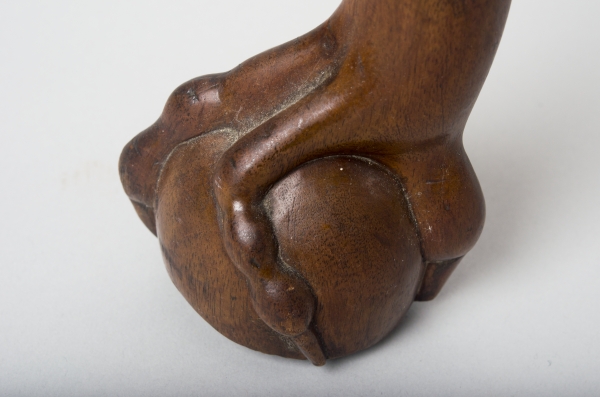
FIG. 24. Claw-and-ball foot of the side chair in fig. 23. Photo, Laura Wulf.
Double-Tiered Lancet
New England chairs with flared rear feet and that lacked stretchers were included in this study, but close examination of their construction was required before assigning an attribution. The final chair thought to have originated in the shop—an example with a double-tiered lancet splat (fig. 25)—demonstrate the necessity of understanding details before attempting to identify the maker. This chair is similar to those in a set of six owned by the wealthy Boston merchant James Swan (1754–1830).16 The ears of the crest rail are rounded and the stiles have a molded rather than flat cross-section, all later features. In addition, the rear seat rail is made of solid mahogany, rather than veneered, a departure from earlier work. The rear feet are flared, round-headed wrought nails are used in holes, all interior wood corners are chamfered, and the Roman numeral marking is the same size and in the same location as on other chairs mentioned previously. By contrast, the Swan chairs deviate from these characteristics, and were not considered as having been made in the same shop, despite an overall appearance that is virtually identical.
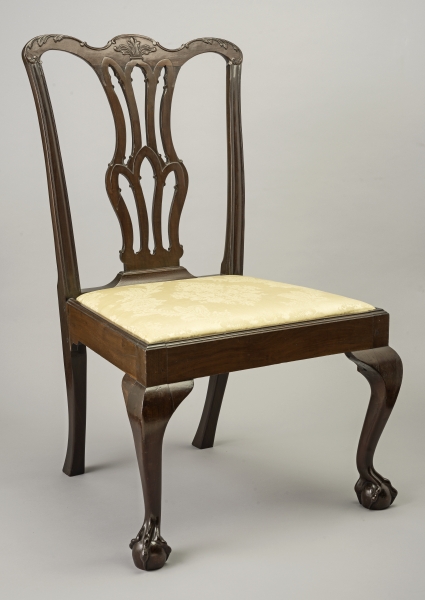
FIG. 25. Side chair with double-tiered lancet splat, attributed to James Graham, Boston, 1770–85. Mahogany, white pine; h 37⅞, w 23⅝, Seat d 18½. Winterthur Museum; Museum purchase (1954.0532).
Upholstered Seating
The characteristics that define this large group of chairs are also observed on two beautifully sculptured settees (fig. 26 and an easy chair with hairy paw feet (seen in fig. 27).17
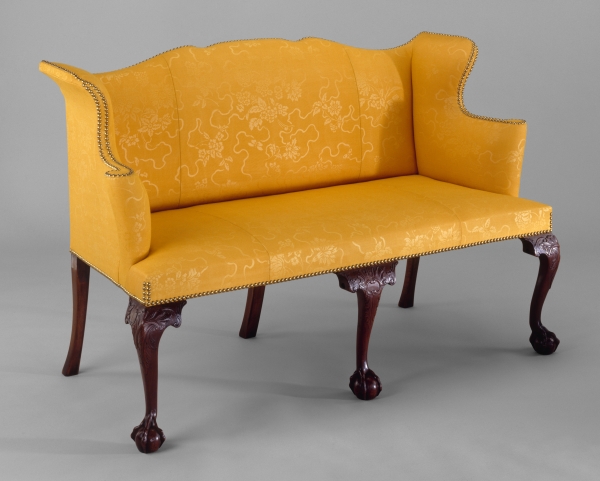
FIG. 26. Settee, attributed to James Graham, Boston, 1758–70. Mahogany, maple, birch, cedar, white pine; h 36⅜, w 57½, Seat d 22⅝. Metropolitan Museum of Art; The Sylmaris Collection, Gift of George Coe Graves, 1930 (30.120.59).
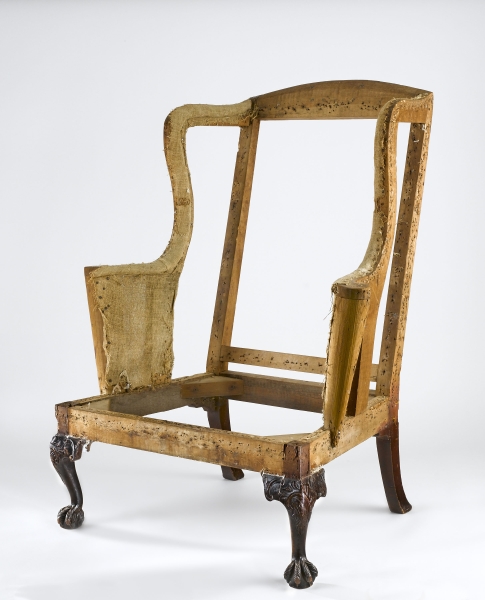
FIG. 27. Easy chair, attributed to James Graham, Boston, 1756–80. Mahogany, maple, eastern hemlock; h 45¼, Seat w 30½, Seat d 22. Private collection. Photo, Gavin Ashworth.
IDENTIFYING THE MAKER
Despite the large number of sets and individual chairs that have survived and the identification of early owners, all efforts to locate a bill of sale linking an original owner to the specific Boston chairmaker have been unsuccessful. However, some clues indicated a profile of the probable maker.
Yehia’s discussion of the source of the loop-and-diamond splat chairs suggested they were made by a domestic chairmaker who copied an English import.18 All such chairs share construction details with the balance of chairs in this study, which derive their designs from multiple English pattern books of the period. Although one design may have been copied from an imported example, it is highly unlikely that a domestic chairmaker had access to a minimum of three different English pattern books (Chippendale, Ince & Mayhew, and Manwaring) for splat designs and decided to incorporate English joinery practice in making the chairs rather than employing typical New England construction. All but the C-scroll and chevron splat have precedents in English furniture. It is also unlikely that a domestically trained chairmaker would suddenly change chair proportions from New England to English parameters. The large number of existing sets, coupled with design elements that span the Chippendale period from its early through its late stages, indicates a longstanding shop.
In addition, three distinctive construction methods were particularly important in drawing conclusions about the chairmaker’s background. They are the use of crossbracing, in addition to corner blocks, on overupholstered chairs; the presence of veneered rear rails; and the laminated construction of the knee brackets. Although laminated construction for knee brackets was quickly abandoned, undoubtedly because of a plentiful supply of mahogany, its use was a key detail. All three methods indicated an English craftsman trained to conserve costly primary wood, even at the expense of shaping and gluing two pieces of wood together. The maker also tenoned the shoe for the splat into the stile. Although seen on only one example and undoubtedly abandoned as unnecessary and labor intensive, it was potentially a key piece of evidence if its precedent could be found. The three deeply incised grooves emanating from the crest rail ear also were noteworthy but of unknown significance.
These clues led to the conclusion that the chairmaker was an immigrant from the British Isles. But who was he? The comprehensive cabinet- and chairmaker index compiled by Myrna Kaye in Boston Furniture of the Eighteenth Century was used as the starting point for compiling backgrounds about potential makers who fit this profile—a substantial group in colonial Boston.19 In addition, three scholars of English furniture were supplied with photographs and a summary of the group’s characteristics, with the hope that they might recognize English precedents for design and construction details.20 Each indicated that the chairs were not based on London, southern English, or Irish examples but suggested either a northern English or Scottish influence. Further research indicated that carving deep grooves in the crest rail was a Scottish embellishment.21
This information allowed for a focus on identifying a Scottish immigrant craftsmen who fit the defined parameters. Research subsequently yielded one strong possibility: James Graham, a chairmaker identified by Kaye as renting a shop on Mackerel Lane in Boston from 1762 to 1771. But a complication arose. The records of the Scots Charitable Society of Boston seemingly disclosed two chairmakers named James Graham who arrived in Boston from Scotland.22 The first was from Kirkwall, in the Orkney Islands, and emigrated in August 1754. The second was listed as being “born on the island of Rosey [sic] in the Orkneys” and entered in May 1767. Determining which artisan made this group of chairs became the next question to address, for it was reasonably certain that it was one or the other. Eventually it became clear that only one James Graham was involved.
Graham’s presence in Boston is first noted on August 1, 1754, when he paid initial dues of £3.3.0 to the Scots Charitable Society, a group that raised money from incoming Scottish immigrants for the benefit of Scottish widows and orphans. He paid his quarterly dues of five shillings continuously until May 1760, when the minutes indicate that several Scots lost everything in the great fire in March of that year (fig. 28). After two quarters, he resumed paying dues, until May 1762. His initial eight-year membership in the society was much longer than that of most immigrants. For the next twenty years, there is no mention of his attendance, but in July 1782 he resumed attending meetings and recruited three new members. By this time, the society’s attendance had fallen significantly, with some meetings being adjourned for lack of a quorum. In 1789, Graham is listed as being “excused,” and he petitioned the society for assistance in January 1790, which was granted until May 1804. Assistance given to a male applicant was highly unusual and was probably granted in light of Graham’s earlier faithful attendance.
The fire records at the Boston Public Library reveal that Graham was renting a shop from Rebecca Amory at £2.13.4 per year on Mackerel Lane, adjacent to cabinetmakers Edmund and James Perkins. The fire was devastating. It destroyed not only the shop but also his work and tools, amounting to a claimed loss of £41.13.8. Despite the misfortune, in December 1760 he married Jane Freeland, daughter of cabinetmaker William Freeland, who had similarly lost his shop in the fire, claiming total losses of £109.9.4.
FIG. 28. Angel of Death Flying over the Great Boston Fire, printed by Zechariah Fowle and Samuel Draper (active 1757–62), Boston, 1760. Woodblock print; h 213/16, w 3⅞. Library Company of Philadelphia.
Graham next obtained working quarters from the wealthy landowner Dr. John Clark, but the rent of £4.13.4 was 75 percent greater than what he was paying before the fire.23 Graham generally paid on time until 1765, when he committed to renting a house from Clark at £14 per year. At the same time, Clark increased Graham’s workshop rent by 28 percent. The two commitments, totaling £20 per year, equaled nearly 50 percent of Graham’s total assets prior to the fire. The next five years were difficult. His rent payments were consistently late, resulting in the loss of his house in 1770; his father-in-law, William Freeland, came to the rescue by paying half of a two-year-overdue bill. Graham then lost the lease on his shop in May 1771. He had paid no rent for almost five years prior to termination.
Graham’s presence in Boston is also noted in tax and census documents between 1760 and 1780, in which his occupation is listed as chairmaker. In 1784, Graham signed a deed transferring ownership of the Green Dragon Tavern; in it, his occupation is listed as “cabinetmaker” (fig. 29), an important change in nomenclature.24 The Tavern was owned by and served as the meeting place of the St. Andrew’s Lodge of Freemasons. Graham was a founding member of the organization in 1756, and Paul Revere and Dr. Joseph Warren were among his fellow brethren. Politically, Graham was firmly aligned with the Revolutionary cause, as were other lodge members, and he signed the Nonimportation Agreement in July 1769.25 By 1782, Graham had applied for a license as a retailer, evidently trying to supplement his cabinetwork. He received charitable assistance for the last ten years of his life and passed away in 1808.
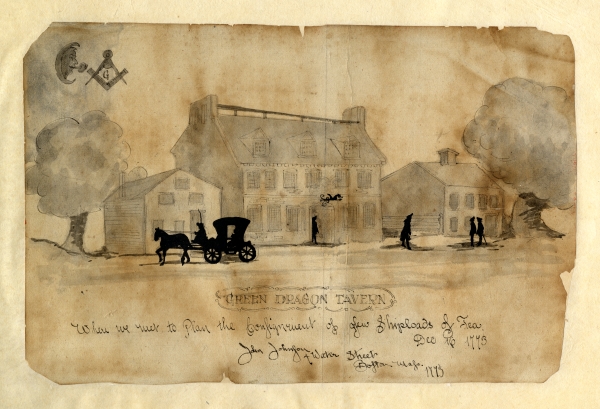
FIG. 29. The Green Dragon Tavern, drawn by John Johnson (1753–1818), Boston, 1773. Pen and ink with watercolor wash on paper; h 8⅜, w 12⅛. American Antiquarian Society.
During the prerevolutionary period, it was extremely difficult for immigrant craftsmen to settle in Boston without proving their ability to earn a living. Although there are no known relatives who could have acted as sponsors for Graham, his position as a founder of St. Andrew’s Lodge less than two years after his arrival indicates that he had been raised as a Mason prior to leaving Scotland. Membership in this organization was critical for his acceptance among Boston craftsmen. Lodge members included not only prominent revolutionaries but also members of the Caucus Club, an organization of artisans that exerted significant influence on staffing key positions governing Boston commercial activity.26
Having documented Graham’s activity in Boston from 1754 onward, the challenge became to trace his origins in Scotland prior to that date. Research revealed that James Grayham (as he was identified in the local records) was born about 1728 on the Orkney island of Rousay; he was the first and only son of the Reverend Andrew Graham (1688–1746) and his wife, Christian Flett Graham (d. 1772).27 Although the family had a long history of holding elevated positions in the church, James’s father encountered difficulty securing a ministerial position.
Rather than follow in the footsteps of three generations of clergymen, James was apprenticed to cabinetmaker William Manson of Stromness (fig. 30).28 An examination of available eighteenth-century furniture from the Orkneys revealed only one of the features seen in the group of chairs studied: the three deep grooves in the crest rail. Chairs from the islands are well constructed but basic in design. Since the population of the Orkney Islands could support no more than one or two cabinetmakers, Graham probably left about 1748, after completing his apprenticeship. Efforts to determine his whereabouts for the next six years have been unsuccessful, but he likely worked in northern Yorkshire, England. All the unusual construction features cited in this study have been observed in chairs at museums in Yorkshire.29 He may have returned to Scotland, probably in early 1766, and then sailed back to America sixteen months later; the Scots Charitable Society records state that Graham, “born on the island of Rosey,” reentered in May 1767. (This notation, referencing Graham’s second arrival, was the source of the initial speculation that two craftsmen named Graham, rather than one, were at work in Boston.)
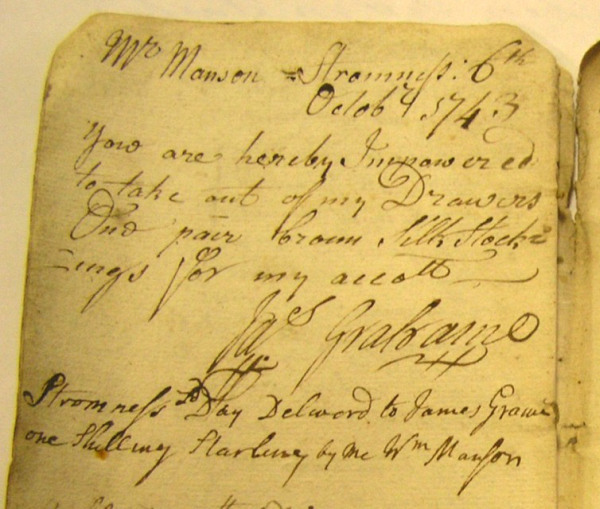
FIG. 30. James Graham account, October 6, 1743. From “William Manson’s Day Accounts and Letters,” Orkney Archives, Orkney Islands, Scotland (D2/9/8). In this entry, Graham gives permission to his master, William Manson, to remove one pair of brown silk stockings from a case of drawers and is paid one shilling.
The final bit of evidence linking James Graham to this body of work is the change in his occupation, from “chairmaker” on earlier listings to “cabinetmaker” on the second deed transferring ownership of the Green Dragon. Several pieces can be attributed to Graham based on the same joining characteristics as those in his chair construction: asymmetrically carved knees, counterbored nail holes, round-headed nails, chamfered edges of glue blocks, the carving style on claw-and-ball feet and acanthus-leaf knee carving, stop-fluted posts, and the use of premium-grade high-density mahogany. The first is a high-post bedstead (fig. 31).30 Second is a group of three card tables. One table in particular (fig. 32 and see also fig. 17) illustrates his relative lack of knowledge when manufacturing furniture outside his comfort zone of chairmaking. Its dimensions are larger than typical card tables of the time, and the top is rabbeted around the edge in securing the top to the frame, a labor-intensive and completely unnecessary construction method.
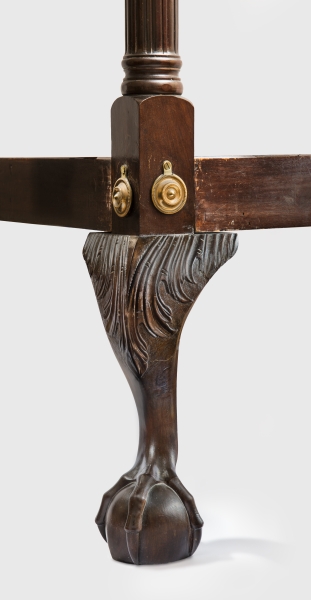
FIG. 31. Carved foot post of high-post bedstead, attributed to James Graham, Boston, 1760–80. Mahogany, birch, maple, white pine; overall h 82, w 587/16, d 76½. Private collection. Photo, Gavin Ashworth.
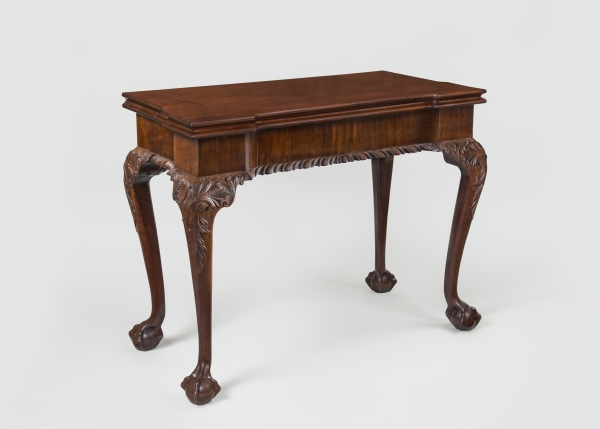
FIG. 32. Card table, attributed to James Graham, Boston, 1762–75. Mahogany, maple, white pine; h 28¼, w 35½, d 17½. Private collection. Photo, Gavin Ashworth.
One of the more surprising and frustrating aspects of the research was the absence of any reference to Graham in the records of known customers or receipts for his work, despite the high volume of chairs produced. A possible explanation is that Graham engaged agents to sell his output or supplied other chairmakers and cabinetmakers rather than selling directly. Doing so would have reduced his profits but supports the observation that he managed his finances poorly. Two documented instances may support this theory that his chairs were retailed through other craftsmen.
Sets of chairs with a history of ownership by Elias Hasket Derby (1739–1799) and Benjamin Pickman Esq. (1740–1819), wealthy Salem patrons, may shed some light on this possibility. In both cases, the majority of the dowry for each man’s bride was purchased from Salem cabinetmaker Nathaniel Gould and is well documented in his ledgers. Neither order, however, included expensive mahogany chairs, a distinct departure from the usual wedding order for persons of this rank.
The ledgers of Richard Derby (1712–1783), Elias’s father, list a set of chairs being purchased through Derby’s agent in Boston from the Putnam chairmaking family in April 1761, the same month as the marriage. No other large chair order appears in Derby account books at around this time, and the order is assumed to be the chairs made by Graham but sold through the Putnams.31
Identical circumstances occurred a year later for the dowry furniture purchased for Mary Toppan’s marriage to Benjamin Pickman Esq. in April 1762. Her father, Dr. Bezaleel Toppan, augmented his dowry order of furniture from Gould by purchasing nine expensive mahogany chairs from Boston cabinetmaker George Bright (1727–1805) in June, the set assumed to be the Graham chairs (see fig. 14).32
If he supplied other cabinetmakers with his product routinely, as the above cases suggest, he would have lost significant profit margin and the leverage he might have commanded in the marketplace from the introduction of the new Chippendale style. This is obviously conjecture, but might account for the lack of documented sales transactions by Graham.
From the few surviving records, we may deduce that Graham lived in poverty for the last twenty years of his life. Although he was a highly accomplished craftsman and popular with contemporaries, he was not a leader and poorly managed his financial affairs. Nevertheless, he may well have introduced a new Chippendale style to Boston society shortly after arriving in 1754. He leaves a body of work of superior craftsmanship that displays the finest elements of rococo design during the third quarter of the eighteenth century.
APPENDIX: CHAIRS ATTRIBUTED TO JAMES GRAHAM
The following checklist provides information on sets of chairs examined by the author. Chairs on adjacent lines are from the same set; a line space between indicates that the chairs, while related, are from different sets. Other chairs possibly by Graham have appeared in the literature but were not included here because the author has not studied them in detail (with the exception indicated in note 1). The number of chairs that could be attributed to Graham may be as many as 150.
In the “Seat Number on Rear Rail” column, the chair number for slip seats is listed. When the number on the original slip-seat frame differs from the numbers on the rail, the difference is noted in parentheses. These numbers are useful in estimating the original quantity of chairs in a set.
The figure numbers given for the splat designs refer to illustrations in this essay. “C&B” stands for claw-and-ball feet. For chairs now in private collections (p), a reference to their appearance in an auction catalogue (cited by auction house, date of auction, and lot number [l]) or other publication is provided. A few chairs are as yet unpublished. In several instances, original ownership information is also indicated.
| Splat Type | Chair Form | Primary Wood | Foot Type | Knee Type | Knee Bracket | Stile Type | Seat | Crest Rail Carving | Seat Number on Rear Rail (number on slip seat) | Surviving Examples | Current Ownership (acc. no.); Original Owner |
|---|---|---|---|---|---|---|---|---|---|---|---|
|
Lancet & Keyhole (fig. 10) |
Corner |
Mahogany |
C&B, early period |
Scallop shell and bellflower |
Ogee |
Fluted |
Slip seat |
1 |
p: Sotheby’s, 9/30/2010, l70 |
||
|
C Scroll (fig. 7) |
Side |
Mahogany |
Scribed pad |
Acanthus |
Carved |
Plain |
Slip seat |
3 incised grooves |
VI |
1 |
p: Christie’s, 1/16/1999, l673 |
|
Side |
Mahogany |
Scribed pad |
Acanthus |
Carved |
Plain |
Slip seat |
3 incised grooves |
Not recorded |
1 |
P: Skinner, 6/8/1997, l154 |
|
|
Arm |
Mahogany |
Scribed pad |
Plain |
Volute (laminated) |
Plain |
Over-upholstered |
3 incised grooves |
None |
2 |
King’s Chapel, Boston |
|
|
Side |
Black walnut |
Scribed pad |
Plain |
Volute |
Stop fluted |
Slip seat |
Ogee and 2 beads |
I, VII |
2 |
P: By descent from Tripp family, Easton, Md. |
|
|
C Scroll and Diamond (fig. 11) |
Arm |
Mahogany |
C&B, middle period |
Acanthus |
Carved |
Plain |
Over-upholstered |
3 incised grooves |
None |
1 |
P: Sotheby’s, 1/20/2002, l1088; ancestor of Thomas Atkins 1792–1856 |
|
Side |
Mahogany |
C&B, middle period |
Acanthus |
Carved |
Plain |
Over-upholstered |
3 incised grooves |
None |
7 |
P: Sotheby’s, 1/20/2002, l1088 (5); ancestor of Thomas Atkins 1792–1857; P: Northeast, 8/2/1998, l829 (2); ancestor of Thomas Atkins, 1792–1856 |
|
|
Side |
Mahogany |
C&B, late period |
Plain |
Ogee |
Plain |
Slip seat |
Ogee and 2 beads |
I, II, III, IIII, V, VI |
6 |
Private |
|
|
Side |
Black walnut |
Scribed pad |
Plain |
Ogee |
Plain |
Slip seat |
Ogee and 2 beads |
II, IIII, VI |
3 |
P: Skinner, 2/27/2000, l111 (1); P: Northeast, 8/6/2011, l906 (2) |
|
|
Side |
Black walnut |
Scribed pad |
Plain |
Ogee |
Plain |
Slip seat |
Ogee and 2 beads |
III, IIII, V, VI |
4 |
P: Freeman’s, 11/20/2010, l35 |
|
|
C Scroll and Chevron (fig. 12) |
Corner |
Mahogany |
Scribed pad |
Plain |
Ogee |
Fluted |
Slip seat |
1 |
Colonial Williamsburg (1974–35,6) |
||
|
Side |
Mahogany |
Scribed pad |
Plain |
Ogee |
Stop fluted |
Slip seat |
Ogee and 2 beads |
I, II, III, IIII, V, VI, VII, VIII |
8 |
Colonial Williamsburg (1974–35,1–5; 1974–36,1–3) |
|
|
Figure Eight and Diamond (fig. 13) |
Side |
Mahogany |
Hairy paw |
Asymmetrical |
Carved |
Plain |
Slip seat |
Ogee and 2 beads |
VII |
1 |
Winterthur Museum (1952.0242) |
|
Side |
Mahogany |
Hairy paw |
Asymmetrical |
Carved |
Plain |
Slip seat |
Ogee and 2 beads |
V |
1 |
Art Institute of Chicago (1991.266) |
|
|
Side |
Mahogany |
Scribed pad |
Plain |
Ogee |
Stop fluted |
Over-upholstered |
Ogee and 2 beads |
None |
3 |
P: By descent, Dr. Augustus Holyoke, Salem |
|
|
Side |
Mahogany |
Scribed pad |
Plain |
Ogee |
Stop fluted |
Over-upholstered |
Ogee and 2 beads |
None |
3 |
Peabody Essex Museum (124.432.1–3); Holyoke descent |
|
|
Mahogany |
Scribed pad |
Plain |
Ogee |
Plain |
Slip seat |
Ogee, 2 beads, and center groove to ear |
VII |
1 |
P: Sack, 9:24803 |
||
|
Side |
Mahogany |
C&B, early period |
Plain |
Volute |
Stop fluted |
Slip seat |
Ogee, 2 beads, and center groove to ear |
VII (seat: III) |
1 |
Metropolitan Museum of Art (1973.207) |
|
|
Side |
Mahogany |
C&B, early period |
Plain |
Volute |
Stop fluted |
Slip seat |
Ogee and 2 beads |
V |
1 |
P: Northeast, 8/3/1997, l674 |
|
|
Side2 |
Mahogany |
C&B, early period |
Plain |
Ogee |
Stop fluted |
Slip seat |
Ogee and 2 beads |
VI (seat: I) |
1 |
P: Antiques and the Arts Weekly, 9/14/2001, 123 (Liverant) |
|
|
Side2 |
Mahogany |
C&B, early period |
Plain |
Ogee (laminated) |
Stop fluted |
Slip seat |
Ogee and 2 beads |
IIII |
1 |
P: Northeast, 8/4/2002, l920 |
|
|
Side |
Mahogany |
Scribed pad |
Plain |
Volute |
Stop fluted |
Slip seat |
Ogee, 2 beads, and center groove to ear |
I, II |
2 |
Private |
|
|
Side |
Mahogany |
C&B, early period |
Acanthus |
Carved (laminated) |
Plain |
Over-upholstered |
3 incised grooves with carved shell at crest |
None |
2 |
P: Christie’s, 1/18/1997, l191 |
|
|
Mahogany |
C&B, middle period |
Plain |
Ogee |
Plain |
Over-upholstered |
3 incised grooves with carved leaf at crest center |
None |
5 |
P: Nordblom, 5/31/1998, l50 (2); dePhillipo, 9/23/2008, l108 (2); by descent, Benjamin Pickman, Salem; P: Sotheby’s, 2/1/1991, l810 (1) |
||
|
Side |
Mahogany |
C&B, middle period |
Plain |
Ogee |
Plain |
Over-upholstered |
Ogee & 2 beads |
None |
2 |
Currier Museum of Art (1958.4.1,2) |
|
|
Side1 |
Mahogany |
C&B, middle period |
Plain |
Ogee |
Plain |
Over-upholstered |
2 incised grooves with carved leaf at crest center |
None |
6 |
P: Sotheby’s, 2/1/1991, l809 |
|
|
Gothic Arch (fig. 18) |
Side |
Mahogany |
C&B, middle period |
Acanthus |
Carved |
Plain |
Over-upholstered |
Fully carved leafage |
None |
1 |
Milwaukee Art Museum (M1976.37) |
|
Side |
Mahogany |
C&B, middle period |
Acanthus |
Carved |
Plain |
Over-upholstered |
Fully carved leafage |
None |
2 |
P: Skinner 3/25–27/1976, l 280 |
|
|
V Shape, Double Lancet, and Keyhole (fig. 20) |
Side |
Mahogany |
Hairy paw |
Asymmetrical |
Carved |
Stop fluted |
Slip seat |
Carved leafage ears, center plain |
I, II, III, V, VI |
5 |
P: Sack, 4:1080 (4)3; P: Sotheby’s 2/1/1991, l771 (1) |
|
Side |
Mahogany |
Hairy paw |
Asymmetrical |
Carved |
Stop fluted |
Slip seat |
Fully carved leafage |
VI (seat: V) |
1 |
Museum of Fine Arts, Boston (1996.52); Moses Gill, Boston |
|
|
Side |
Mahogany |
Hairy paw |
Asymmetrical |
Carved |
Stop fluted |
Slip seat |
Fully carved leafage |
V, I |
2 |
P: Christie’s,1/16/1999, l701 (1); Private; Moses Gill, Boston |
|
|
Side |
Mahogany |
Hairy paw |
Asymmetrical |
Carved |
Stop fluted |
Slip seat |
Fully carved leafage |
I, II (seats: I, VIII) |
2 |
Wadsworth Atheneum (1999.3.1, 1993.3.3); Moses Gill, Boston |
|
|
Mahogany |
Hairy paw |
Asymmetrical |
Carved |
Stop fluted |
Slip seat |
Fully carved leafage |
X |
1 |
Wadsworth Atheneum (1999.3.2); Moses Gill, Boston |
||
|
Arm |
Mahogany |
C&B, middle period |
Asymmetrical |
Carved |
Stop fluted |
Slip seat |
Fully carved leafage |
III (seat: VII) |
1 |
P: Sack, 3:614; E. H. Derby (Salem)3 |
|
|
Side |
Mahogany |
C&B, middle period |
Asymmetrical |
Carved |
Stop fluted |
Slip seat |
Fully carved leafage |
I |
1 |
Chipstone Foundation (1971.3) |
|
|
Arm |
Mahogany |
C&B, middle period |
Asymmetrical |
Carved |
Stop fluted |
Over-upholstered |
Fully carved leafage |
None |
2 |
Yale University Art Gallery (1967.26–27) |
|
|
Side |
Mahogany |
C&B, middle period |
Asymmetrical |
Carved |
Stop fluted |
Over-upholstered |
Fully carved leafage |
None |
10 |
Yale University Art Gallery (1967.28.1–10) |
|
|
Side |
Mahogany |
Hairy paw |
Asymmetrical |
Carved |
Stop fluted |
Over-upholstered |
Fully carved leafage |
None |
1 |
P: Bourne 5/17/1975, L265 |
|
|
Side |
Mahogany |
Hairy paw |
Asymmetrical |
Carved |
Stop fluted |
Over-upholstered |
Fully carved leafage |
None |
1 |
Unknown |
|
|
Interlaced Scrolls (fig. 23) |
Side |
Mahogany |
C&B, late period |
Plain |
Ogee |
Molded |
Over-upholstered |
Plain |
None |
2 |
P: Sotheby’s 10/7/2006, L274 |
|
Double-Tiered Lancet (fig. 25) |
Side |
Mahogany |
C&B, late period |
Plain |
Ogee |
Molded |
Slip seat |
Carved with Prince of Wales feather |
I |
1 |
Winterthur Museum (1954.0532) |
|
Total |
100 |
1. This set, although not personally examined, illustrates all the characteristics of Graham’s work and is attributed to him here.
2. Listed as two different sets despite the presence of matching attributes. A construction feature distinguishes the two sets. On one, the knee brackets are laminated and tenoned to the leg, a method indicative of earlier production than the standard one-piece brackets seen on the other set.
3. See individual volumes of Israel Sack, Inc., American Antiques from Israel Sack Collection, 10 vols. (Washington, D.C.: Highland House, 1969–92).

1. Mary Ellen Hayward Yehia, “Ornamental Carving on Boston Furniture of the Chippendale Style,” in Boston Furniture of the Eighteenth Century: A Conference Held by the Colonial Society of Massachusetts, 11 and 12 May 1972, ed. Walter M. Whitehill, Jonathan L. Fairbanks, and Brock Jobe, Publications of the Colonial Society of Massachusetts, vol. 48 (Boston: Colonial Society of Massachusetts, 1974), 197–22, esp. 201–2 and chart 1.
2. Important American Furniture, Christie’s, Jan. 18, 1997, lot 191.
3. Important American Furniture, Silver, Prints, Folk Art and Decorative Arts, Christie’s, Jan. 15–16, 1999; for the interlaced C-scroll splat chair, see lot 673; for the loop and diamond splat, lot 701. The shared characteristics as listed by Yehia, “Ornamental Carving,” 202, chart 1, are asymmetrical knee carving with either hairy paw or claw-and-ball feet; maple or oak rear seat rails veneered with mahogany; and triangular corner blocks with a thin chamfered edge held in place by round-headed nails. See also Luke Beckerdite, “Carving Practices in Eighteenth-Century Boston,” in New England Furniture: Essays in Memory of Benno M. Forman, ed. Brock Jobe (Boston: Society for the Preservation of New England Antiquities, 1987), 123–62. Beckerdite calls attention to an English chair of this type (fig. 7). An English side chair (acc. no. 30.726) stamped by T. Hooper, now in the collection of the Museum of Fine Arts, Boston (hereafter MFA), was owned originally by the merchant William Phillips of Boston and is also very closely related to the Gill chairs.
4. Chairs with scribed-pad feet were attributed to a Salem chairmaker as a result of three chairs with this feature and a long Salem history that had been donated to the Peabody Essex Museum; Brock Jobe and Myrna Kaye, with the assistance of Philip Zea, New England Furniture, the Colonial Era: Selections from the Society for the Preservation of New England Antiquities (Boston: Houghton Mifflin, 1984), 393. See note 9 for clarification as to the provenance of these chairs.
5. The combination of the parameters of types of splat, foot, knee, stile, knee return, and ear, as well as whether the chair was overupholstered or had a removable seat, usually were sufficient in determining discrete sets. Additional distinctions were made possible by comparing foot carving and seeing whether the numbering system was duplicated (two chairs with identical features were considered to be from different sets if both had the same number).
6. Sotheby’s, Sept. 30, 2010, lot 70.
7. A set of six (two known survivors) walnut chairs with C-scroll splats that descended in the Trippe family of Maryland’s Eastern Shore. A set of four C-scroll and diamond splats was sold at Freeman’s auction house, Philadelphia, Nov. 20, 2010, lot 35. Three walnut C-scroll and diamond splat chairs, considered to be from the same set, were sold at separate auctions; see Skinner, Feb. 27, 2000, lot 111, and a pair at Northeast Auctions, Aug. 6, 2011, lot 906. Two of the sets have scribed-pad feet.
8. C-scroll and diamond splats were popular in New York and Connecticut. See John T. Kirk, American Chairs: Queen Anne and Chippendale (New York: Alfred A. Knopf, 1972), 118–44 (New York chairs), 48 (two Connecticut chairs).
9. Speculation about a possible date of manufacture of Dr. Holyoke’s chairs is based on observations gleaned from the account book of Nathaniel Gould. Sets of chair purchases in his accounts were largely determined by a marriage. Holyoke first married Judith Pickman, daughter of Benjamin Pickman (1740–1819); see n. 11. Judith died in 1756, and on Nov. 22, 1759, Holyoke married Mary Viall (1737–1807), daughter of Nathaniel Viall (dates unknown), Esq., of Boston. The set of chairs could have been purchased by either bride’s family. See Kemble Widmer and Joyce King, et al., In Plain Sight: Discovering the Furniture of Nathaniel Gould (Salem, Mass.: Peabody Essex Museum in association with D. Giles, London, 2014), appendix D (marriages).
10. See Harvard Tercentenary Exhibition: Furniture, Silver Pewter, Glass, Ceramics, Paintings, Prints Together with Allied Arts and Crafts of the Period, 1636–1836 (Cambridge: Harvard University Press, 1936), 56.
11. Two of a set of four chairs have descended through seven generations after their probable purchase by Toppan for Mary’s wedding in April 1762. The chairs may have left Salem in 1775 when the younger Benjamin, a staunch Loyalist, moved to England, where he spent the next ten years, leaving his wife in Salem to raise the family. Prior to his departure, a boat loaded with family furniture departed for Nova Scotia. If the chairs were not taken then, they certainly were in the possession of Francis Willoughby Pickman (1804–1870), Benjamin’s grandson, who immigrated to Nova Scotia prior to 1826. They remained in the possession of four generations of Canadian descendants until acquired by the present owner in 2008. For a copy of the receipt of these chairs, dated June 1, 1762, and from George Bright, see Pickman Family Manuscripts, MSS 5, Toppan Family Papers, box 10, folder 1, Peabody Essex Museum, Salem, Mass. (hereafter PEM). See also Benjamin Pickman, The Diary and Letters of Benjamin Pickman (1740–1819) of Salem, Massachusetts, ed. George Francis Dow (Newport, R.I., 1928), 47–48; additional information from a family genealogy provided to the author by the seventh generation of descendants of Col. Benjamin Pickman. Supporting the theory that the chairs were part of the wedding dowry of Mary Toppan Pickman is the fact that her father gave her extensive furniture at the time of her wedding, including three beds, three tables, two stands, a bombé chest of drawers, and a high chest, but no chairs. The pattern of wealthy Salem families purchasing dowry furniture from Nathaniel Gould—excluding chairs, which were purchased from Boston—was observed several times (see n. 9).
12. Thomas Chippendale, The Gentleman and Cabinet-Maker’s Director (London, 1754), pl. 12.
13. See Christopher Gilbert, Furniture at Temple Newsam House and Lotherton Hall: A Catalogue of the Leeds Collection, 2 vols. ([Leeds]: National Art Collection Fund and Leeds Art Collections Fund, 1978), vol. 1, cat. no. 73.
14. Two of Lt. Gov. Gill’s chairs are in private collections, another is at the MFA (see fig. 6), and two side chairs and the slipper chair are in the collection of the Wadsworth Atheneum, Hartford, Conn. Gill’s inventory of 1795 lists under chairs: “7 Neat carved mahogany [Horsehair] stuff’d Bottom’d,” which might include the example shown here; see Moses Gill inventory, 1795, octavo vol., American Antiquarian Society, Worcester, Mass. For a detailed analysis of a side chair and the armchair from the Belcher set, see Patricia E. Kane, 300 Years of American Seating Furniture: Chairs and Beds from the Mabel Brady Garvan and Other Collections at Yale University (Boston: New York Graphic Society, 1976), 115–17.
15. This chair represents the third example of a prominent Salem merchant purchasing a set of chairs from a Boston chairmaker while buying other furniture locally; see Widmer and King, In Plain Sight, appendix D (marriages). Furniture given to the bride Elizabeth Crowninshield by her father included a relatively inexpensive set of chairs at the time of her marriage in April 1761 to Elias Hasket Derby. He purchased an expensive set in that same month through his Boston agent, John Marston, who had acquired them from a “Mr. Putnam,” a nearby chairmaker. It is assumed that this is the set in question. Richard Derby Miscellaneous Receipts, 1759–1761, MSS37, series II, box 15, folder 4, PEM.
16. Chairs from the set of six sold to Boston merchant James Swan are in the collections of the MFA (RES. 27.78 and RES.27.81) and Yale University Art Gallery (1963.18.2).
17. For a detailed description of two surviving settees, see Nancy E. Richards and Nancy Goyne Evans, with Wendy A. Cooper and Michael Podmaniczky, New England Furniture at Winterthur: Queen and Chippendale Periods (Hanover, N.H.: University Press of New England for the Winterthur Museum, 1997), 181–82, and Morrison H. Heckscher, American Furniture in the Metropolitan Museum of Art, vol. 2, Queen Anne and Chippendale Periods (New York: Random House, 1985), 40–42.
18. Yehia, “Ornamental Carving,” 204–5.
19. Excluded from consideration were chairmakers born in America and working between 1750 and 1790 because of the heavy English influence on chair design. Although many immigrants were listed as a “joiner” in entry papers, this term was loosely applied to a variety of wood trades and does not necessarily indicate a cabinet- or chairmaker. James Graham is not included in this tabulation. Additional information about each craftsman is retained in the author’s files, although little is known about most of them.
Possible candidates from Myrna Kaye, “Eighteenth-Century Boston Furniture Craftsmen,” in Whitehill, Fairbanks, and Jobe, Boston Furniture of the Eighteenth Century, appendix A, include the following:
- A. From Ireland:
- Alexander Nichols—Arrives June 22, 1766; listed as living in Oxford in 1771 tax census, appears to be a yeoman (farmer)
- Robert Hough—Arrives June 1766; no record in Boston
- John or Jonathan Newell—Arrives June 1766; listed in 1771 tax census, possibly a merchant
- Richard Terutch—Arrives Oct. 14, 1767; no record in Boston
- B. From England
- John Arnold—Cabinetmaker, possibly from England; dies in Boston in 1784
- Joseph Clough—Joiner in 1776; one of four with this name in 1771 tax rolls, two of whom were in Boston; no connection found to chairmaking
- Thomas Hopkins—Active 1784–92 in Boston and Falmouth, Me.
- John Jarvis—Arrives May 12, 1768, as a joiner; unclear whether this is a Loyalist who departs Boston prior to American Revolution or the cabinetmaker listed in 1796 and 1810 Boston directories
- William Nelson—Cabinetmaker; advertised spinning wheels in 1754
- Charles Perring (possibly listed as Perrin)—Arrives in 1768 as a joiner; no further reference to occupation other than yeoman in 1771 tax census
- John Powell—Listed as a chairmaker in 1775 by Kaye; probably claimed losses after the 1760 fire of £15.17.10; two are listed, with one owning a shop near Milk and Batterymarch Streets, the center for joinery trades
- [?] Roberts—Arrives from London July 31, 1765; no record in Boston
- C. From Scotland
- William Arnitt—Arrives June 3, 1766; no record in Boston, probably went to New Jersey
- William Latta—Arrives Aug. 29, 1768; moves to Taunton, Mass.; listed as a “trader”; is a Loyalist; jailed and property confiscated, included woodworking tools; returns to Scotland; after war settles in Albany, N.Y., and then Ontario, Canada
- John McClure—Listed as a chairmaker in 1760 by Kaye; no further records in Boston located
- John McKeller—Arrives May 29, 1768; no record in Boston
- James Mull—Arrives June 3, 1766; no record in Boston
- George and Patrick Laply—Arrived July 26, 1764; no record in Boston
20. The scholars are John Cross, London Guild Hall University, and independent scholars Adam Bowett and Bernard D. Cotton
21. David Jones, professor of art history, University of St. Andrews, Scotland, was instrumental in arranging examination of Scottish chairs with three carved grooves in the crest rail. Anella McCallum, Orkney Roots Research, was invaluable in arranging examination of eighteenth-century chairs originating in the Orkney Islands, Scotland, that showed this characteristic. McCallum also performed all research on the Orkney Islands, disclosing information on Graham’s family, island history, and the location of Graham’s apprenticeship.
22. Records of Graham’s attendance in the Scots Charitable Society are contained in “Alphabet for Scots Charity Entry Book, No. 2 Begun 1744,” New England Historic Genealogical Society, Boston.
23. Graham’s records of renting both a shop and a house are in the 1732–71 account book of Dr. John Clark of Boston, Ms. N.2156 oversize, Massachusetts Historical Society (hereafter MHS).
24. See deeds in 144:78 (recorded July 26, 1784) and 189:51 (recorded July 26, 1784, but not acknowledged until July 4, 1798) in Suffolk County Registry of Deeds, Boston.
25. For a copy of the agreement which was signed by Graham, see MSL 1769 July 31, MHS.
26. For a discussion of the importance of the Caucus Club, see Robert Mussey and Anne Rogers Haley, “John Cogswell and Boston Bombé Furniture: Thirty-Five Years of Revolution in Politics and Design,” in American Furniture 1994, ed. Luke Beckerdite (Milwaukee, Wis.: Chipstone Foundation, 1994), 78–79.
27. As compiled in a genealogy chart by McCallum, Orkney Roots Research, 2001. This chart includes information from Fasti Ecclesiae Scoticanae 1929, appendix 5; and Firth and Stenness Church records, Orkney Church records 11/1, minutes for 1732–1743, appendix 6. Graham evidently went back to Scotland, probably in early 1766, returning to Boston in May 1767. Records of his rent payments to Dr. Clark stop after Nov. 1765 for four years.
Andrew Graham, James’s father, graduated from the University of Edinburgh in 1707 with the intention of securing a ministerial position, following in the footsteps of his father, a minister, and grandfather, a bishop. At this time only two paths led to a comfortable, if not wealthy, existence on the islands: being a member of the clergy or becoming a large landowner. The rest of the Orkney Islands population struggled at a subsistence level. Andrew Graham did not receive a parish of his own until 1723, and only after petitioning the church and expressing his “great sorrow and grief for the public displays of drunkenness and accusations of immoral behavior.” Graham’s lapses and misbehavior are detailed at length in file OCR 4/7 and OCR 1/1, Orkney Church records, Orkney Library, Kirkwall.
28. British forces from England had put down a Scottish rebellion in 1745. As retribution, they destroyed many of the houses of large landowners who had supported the rebellion, including several buildings on the Orkney Islands. Manson’s records indicate extensive repair work throughout the islands during this and following years. Manson had knowledge of America, having spent time in Georgia prior to returning to Scotland, and may have acquainted young James Graham with the opportunities available there. Anella McCallum, of Orkney Roots Research, extracted this information from “William Manson’s Day Accounts and Letters,” D2/9/8, Orkney Archives.
29. English chairs were examined at three museums in Yorkshire for unusual characteristics observed on the Boston chairs. The three museums and publications covering their collections are Peter Brown, The Noel Terry Collection of Furniture and Clocks (York, Eng.: York Civic Trust, 1987); and Gilbert, Furniture at Temple Newsam House and Lotherton Hall, vol. 1. Listed below are the catalogue numbers of chairs in their respective publications that exhibit characteristics common with Graham’s chairs:
- Crossbracing used as seat support for over upholstered chairs (Temple Newsam, 73,75; Noel Terry, 56)
- Laminated (primary and secondary wood glued together) knee returns (Temple Newsam, 64, 68; Noel Terry, 53)
- Stop-fluted stiles (Noel Terry, 53, 56, 63)
- Shoe tenoned into chair stile (Noel Terry, 55)
- Round-headed nail in a counterbored hole (Noel Terry, 55)
- Hairy paw foot carving (Noel Terry, 53)
- Two chair splats were virtually identical to those used by Graham:
- V shape with double lancet and keyhole splat (Temple Newsam, 73)
- Gothic arch splat (Noel Terry, 61)
Because of the high concentration of those characteristics in both Boston and Yorkshire, Graham presumably worked in this area before immigrating to America. I wish to recognize the significant research by Caroline Hirst while a student at St. Andrews, including compiling comparative statistics, examining and photographing museum chairs, and capably assisting in other areas of study in Scotland and Yorkshire, England, which made this essay possible.
Chairs of varying dates from the area that Graham came from are in Bernard D. Cotton, “Chairs of the Northern Isles,” Scottish Vernacular Furniture (London: Thames and Hudson, 2008), 231–61.
30. Three card tables and a bed are attributed to Graham, based on decorative details, carving, and construction. One card table is illustrated in Gerald W. R. Ward, The Cabinetmaker and the Carver: Boston Furniture from Private Collections (Boston: Massachusetts Historical Society, 2013), 37; a second card table was offered at The Collection of Mr. and Mrs. Lammot du Pont Copeland, Sotheby’s, Jan. 19, 2002, lot 62. The third table is unpublished. All three are privately owned, as is the bed.
31. Richard Derby Miscellaneous Receipts, 1759–1761, MSS37, series II, box 15, folder 4, PEM.
32. Pickman Family Manuscripts, MSS 5, PEM; Toppan Family Papers, box 10, folder 1, receipt from George Bright dated June 1, 1762, PEM.

